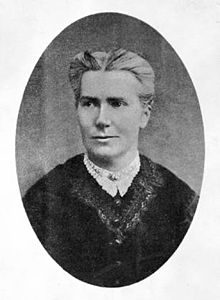Emily Blackwell
Emily Blackwell | |
|---|---|
 | |
| Born | October 8, 1826 Bristol, England |
| Died | September 7, 1910 (aged 83) York, Maine, US |
| Education | Western Reserve |
| Alma mater | Case Western Reserve University |
| Medical career | |
| Profession | Physician |

Emily Blackwell (October 8, 1826 – September 7, 1910) was a trailblazer in the 19th century, making numerous contributions in the field of medicine and women's rights. Emily was the second woman to earn a medical degree at what is now Case Western Reserve University, after Nancy Talbot Clark. In 1993, she was inducted into the National Women's Hall of Fame. Emily made major advancements in the medical scene, assisting in the start of the New York Infirmary for Indigent Women[1] and Children and creating the Women's Central Association of Relief.[2] Emily, along with her sister Elizabeth Blackwell, had established the Women's Medical College in New York City.[3] Shortly after, Emily helped form the London School of Medicine for Women.[3]
Early life and education
Blackwell was born on October 8, 1826, in
Inspired by the example of her older sister, Elizabeth, Blackwell applied to study medicine at Geneva Medical College in Geneva, New York, from which her sister graduated in 1849, but was rejected. After being rejected by several other schools, she was finally accepted in 1853 by Rush Medical College in Chicago, where she studied for a year. However, in 1853, when male students complained about having to study with a woman, the Illinois Medical Society vetoed her admission. Eventually, she was accepted to the Medical College of Cleveland, Ohio, Medical Branch of Western Reserve University, earning her Doctor of Medicine in 1854 with honors.[5]

At
After earning her medical degree, Blackwell pursued further studies in
Career
In 1857, Blackwell, along with her sister Elizabeth and
During the

From 1883, Blackwell lived with her partner Elizabeth Cushier, who also served as a doctor at the infirmary.[8] Although they never married, when Emily had turned 44, she adopted a baby named Nanny.[9] Blackwell and Cushier retired at the turn of the century. Blackwell had viewed her retirement as an opportunity to focus her efforts on the expansion of social formalities by addressing more broad social issues and pushing for continuous societal change.[10] Following Emily's retirement in 1900, the infirmary still stands and does excellent work under a new name, the NYU downtown hospital.[1] After traveling abroad in Europe for a year and a half, they spent the next winters at their home in Montclair, New Jersey, and summers in York Cliffs, Maine.[11] She also frequently traveled to California and parts of Southern Europe for her health. Emily was able to see her sister Elizabeth one final time in 1906 before the eldest Blackwell fell down a flight of stairs and never fully recovered and ended up passing in May 1910.[1] Emily Blackwell died due to enterocolitis on September 7, 1910, in York Cliffs, Maine, a few months after her sister Elizabeth's death in England.[12]
References
- ^ a b c d "Emily Blackwell". History of American Women. 2012-02-07. Retrieved 2023-11-17.
- ^ "Women's Central Association of Relief During the Civil War". jocelyngreen.com. 2012-08-07. Retrieved 2023-11-27.
- ^ a b "Elizabeth Blackwell". britannica.com. Retrieved 2023-11-27.
- ^ a b c "Dr. Emily Blackwell." Retrieved: October 23, 2013.
- ^ Kelly, Howard A.; Burrage, Walter L. (eds.). . . Baltimore: The Norman, Remington Company.
- ^ "EASCFA Exhibitions". www.brooklynmuseum.org. Retrieved 2023-10-20.
- ^ "Women of the U.S. Sanitary Commission". History of American Women. 2015-02-26. Retrieved 2023-10-13.
- ISBN 978-0-618-05697-2.
- ^ "All About Emily Blackwell, A Medical Pioneer". ThoughtCo. Retrieved 2023-12-01.
- ^ "Emily Blackwell | Encyclopedia.com". www.encyclopedia.com. Retrieved 2023-12-01.
- ^ Faderman (2000), p. 289
- ^ "Dr. Emily Blackwell Dead" (PDF). The New York Times. September 9, 1910. Retrieved 2007-06-21.
One of Founders of First Women's Hospital In America.
Further reading
- Webster's Dictionary of American Women, ISBN 0-7651-9793-6.
- Blackwell, Emily. "Blackwell, Emily". American National Biography Online. Oxford University Press. Retrieved March 25, 2017.
- Loue, Sana; Sajatovic, Martha; Cain, Tambra (2004). "Blackwell, Elizabeth". Encyclopedia of woment's health. New York: Kluwer Academic/Plenum Publishers. ISBN 978-0306480737.
- Atwater, Edward C (2016). Women Medical Doctors in the United States before the Civil War: A Biographical Dictionary. Rochester, NY: University of Rochester Press. OCLC 945359277.
- Nimura, Janice P. (2021). The Doctors Blackwell: How Two Pioneering Sisters Brought Medicine to Women and Women to Medicine. W. W. Norton & Company. ISBN 978-0393635546.
External links
- Changing the Face of Medicine — at NIH
- The Emily Blackwell Society — at Case Western
- Papers, 1832–1981. Schlesinger Library, Radcliffe Institute, Harvard University.
- Emily Blackwell at Find a Grave

